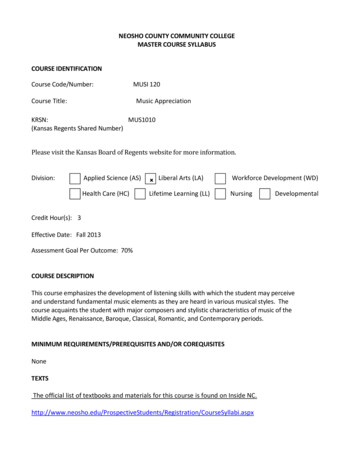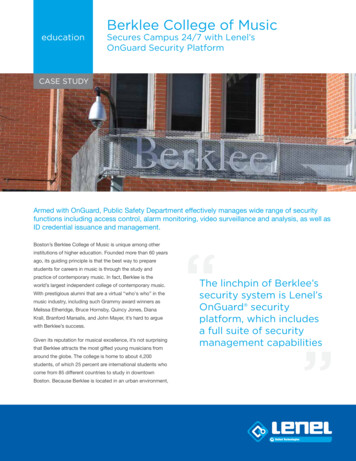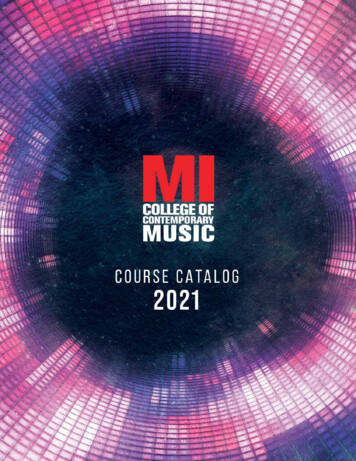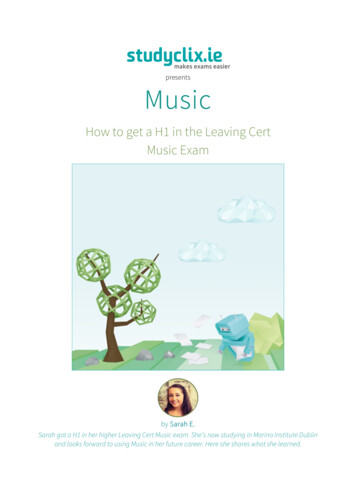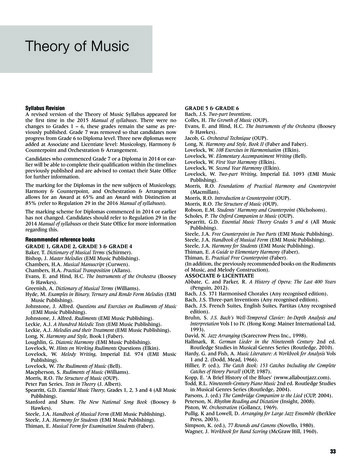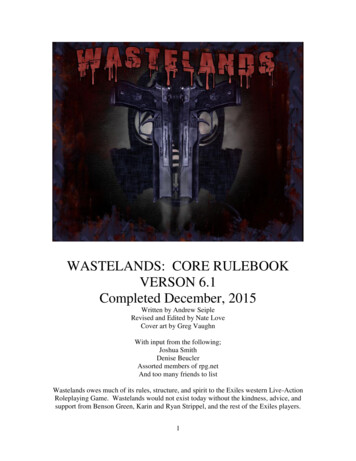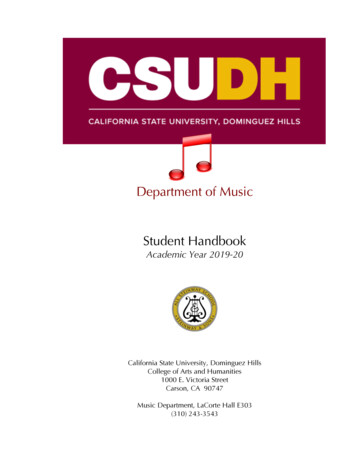
Transcription
Perhaps Contemporary Musicis Not That ContemporaryComparing Classic Evangelical Hymnody and the HottestCCLI Worship SongsPart II: Verbs(What They Say about Divine and Human Activity)Lester RuthDuke Divinity SchoolRobert E. Webber Institute for Worship Studies All rights reserved. Do not reproduce , publish, or distribute without permission.
The Two Bodies of Song The most republished Evangelical hymns(hereafter EH) from 1737 to 1860:70 hymns from 86 hymnals (List from Stephen Marini,“Hymnody as History: Early Evangelical Hymns and the Recovery ofAmerican Popular Religion,” Church History 71:2 (June 2002): 273306.) The most used contemporary worship songs(hereafter CWS) from 1989 to 2012 on thetwice-a-year Top 25 lists from CCLI: 98 songs
Workshop 2: Verbs Perhaps contemporary music is not thatcontemporary: considering verbs. The special focus of consideration: divine andhuman activity, with particular reference to theeconomy of salvation and worship.
Main Questions What range of verbs are used with respect todivine activity and in what numbers? How doesthis compare across the bodies of song? What range of verbs are used with respect tohuman activity and in what numbers? How doesthis compare across the bodies of song? How is divine activity portrayed as singular(of a single Person of the Godhead) orcooperative?
Main Questions What is the portrayal of divine activity from thebroad biblical narrative or history of salvation?What verbs are used for and interpretation givento divine activity regarding Christ’s crucifixion? How dynamic is the sense of time within theeconomy of salvation? Specifically, what is therelationship of the singer to events of the biblicalnarrative?
Methodological Notes Multiple uses of a verb within a single song wascounted as one “instance.” Nouns, e.g., “Savior,” with clear sense of actionwere counted as an verbal “instance.”
ComparisonGreater Number and Range ofHuman Actions/Verbs Total verb instances: EH: Human, 850; Divine, 445 CWS: Human, 547; Divine, 374 Total number of different verbs: EH: Human, 276; Divine, 188 CWS: Human, 178; Divine, 162
ComparisonDivine Activity Primary actor: Son Primary action of the primary actor:redemptive death Similar balance in saving aspect of the death(theories of atonement)
ComparisonDivine Activity Divine Persons don’t act in concert for the mostpart; there is a sense of compartmentalizedaction. Apart from creation, there is little sense of God’shistorical activity with Israel prior to the comingof Jesus Christ.
DifferencesUsually relative, not absolute, differences Movement along a spectrum Impression: these are related bodies of songderiving from pieties that overlap in multiplerespects.
DifferenceKey Divine Verbs
DifferenceKey Human Verbs
DifferenceConnecting with the Divine The direction of the human connection to God:sojourn toward vs. ascent up“I will enter his gates ” (“He Has Made Me Glad”)“We bring the sacrifice of praise into the house ofthe Lord” (“We Bring the Sacrifice of Praise”) EH: Traveling on faith-guided pilgrimage as aprimary human action“Wayfaring men to Canaan bound / Shall only in thisway be found” (“Jesus, My All, To Heaven Is Gone”)
How Heaven is UsedEH: Heaven as destination We travel to heaven.CWS: Heaven as dwelling place of God andthe site for perpetual worship We participate in heaven.
A Home AboveTwo words (home and above) reinforce thedistinction on this point: EH instances of “above”: all references toheaven, usually with connotation of destination CWS instances of “above”: divine abode ormeasure of comparison for noting divinegreatness (e.g., Jesus is above all others.)
DifferenceTo People or To God Relative weight: exhortation/invitation(EH) vs. prayer (CWS) A different take on singing “about God” tosinging “to God”
DifferenceMediated vs. Immediate Praise Sustained, mediated reflection vs. immediateadoration e.g., “O For a Thousand Tongues to Sing” does notimmediately address Jesus Christ in praise. Adoration/worship/exaltation related to greaterabundance of prayer
“Pure” Worship and Adoration Songs A much more recurring aspect of CWS Even when expressed in EH most worship andadoration songs are framed and mediated bysome context or situation.FIAY
DifferenceDynamic Time A nod to a more dynamic sense of time in EHwith respect to the relationship of the singer tothe biblical story or divine saving activity. Dynamic relationship of the time of action Present tense Typology and allegory More of biblical narrative Dependence upon biblical narrative/classiceconomy of salvation
DifferenceThe Human Condition Decreasing frequency and contemplation ofsinful humanity from EH to CWS The greater frequency and the wider range offorms of “sin” in EH. EH: a greater sense of mortality: “we die.”Hark! from the tombs a doleful sound,My ears, attend the cry,“Ye living men come view the ground“Where you must shortly lie.
DifferenceDependence on GodEven to Be Able to Worship From the most republished EH hymn (“Jesus MyAll to Heaven Is Gone”): “Nothing but sin I thee can give / Nothing but lovewould I receive.” The need for divine empowerment for humansto be able to relate to God. EH: some instances of petitioning the Holy Spiritto act to enable righteous human activity.
Pastoral Thoughts & Suggestions Are the things held in common necessarily goodattributes? And the things which changed poordevelopments? Because there are some significant differences,there can be difficulties in cultivatingcongregational cross-genre song singing. Respect liturgical roles of congregational songbeyond prayer for EH
Pastoral Thoughts & Suggestions Recognize different sense of time (tied tostructure but also beyond structure), space, andprimary images (delayed vs. immediate). Recognize critical difference between immediateadoration and mediated, commemorativeadoration. Recognize different views of the nature ofhuman condition and the rectifying of the same.
Learning to “Speak” BothTypesofSong,GenerallyBeing “Conversational”Being “Conversational”With HymnsWith Worship Songs Be patient: hymns are likestories; they take time tounfold and gain intensity bythe end Savor the words: theabundance of words allowthe song to explore in moredetail why God is loved Savor the words, thesequel: finely crafted lyricsin meter and rhyme arepart of the beauty Contemplate a single facet:choruses are like diamonds; thegoal is to settle in on a singlefacet and peer deeply into it,going beyond the words;intensity is gained by how thediamond is turned through theverses, chorus, and bridge Look for the “hook”: focusedwords catch the singer tocontemplate one mighty thingabout why God is loved Beyond the words, the sequel:choruses use common,accessible words and lyrics tolove an uncommon God
Learning to “Speak” BothTypes of Song, Specifically Recognize different sense of time (tied tostructure but also beyond structure), space, andprimary images (delayed vs. immediate). Recognize critical difference between immediateadoration and mediated, commemorativeadoration. Recognize different views of the nature ofhuman condition and the rectifying of the same.
A Word of HopeBeing “bilingual” is possible where leadersare attentive and worshipers are open. The two “languages” are within the same“family.”
Specific Pastoral Suggestions Use materials from both bodies of song ascontemplative poetry without music. Learn toappreciate each genre for its own beauty andstrength. Let people get familiar with a genre outside ofimmediate use in worship and name thedifferences so they have right expectations. Read Robin Parry’s Worshipping Trinity.
With Worship Songs Contemplate a single facet: choruses are like diamonds; the goal is to settle in on a single facet and peer deeply into it, going beyond the words; intensity is gained by how the diamond is turned through the verses, chorus, and bridge Look for the "hook": focused words catch the singer to
